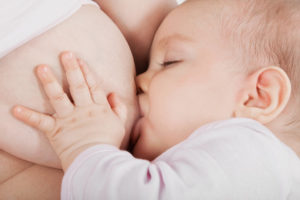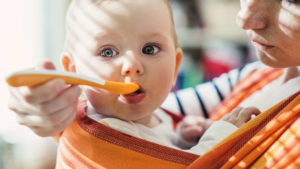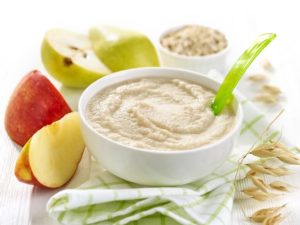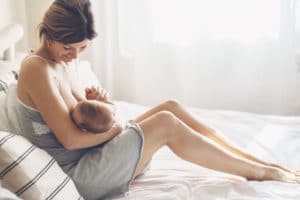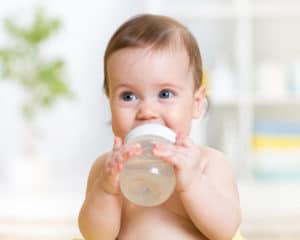If you’re thinking about coloring your hair while breastfeeding, you’ve probably heard many times that it can harm your baby. Many moms are worried when they want to re-dye their hairline or want a whole new color on their heads. You waited a long time before coloring your hair during pregnancy because you didn’t want to endanger your baby.
Whether you are allowed to dye your hair while breastfeeding or not, you can find out here.
Table of contents
How Breast Milk Is Affected
When you breastfeed, your baby receives some or all of its nutrition and fluids through the breast milk you produce. As a rule, the body always adjusts the composition of the milk so that your child receives exactly the nutrients it needs at each stage of development.
If you eat a rich and healthy diet, breast milk will be more caloric than if you are sick or even on a diet. But it is not only what you eat, but also what you take in that goes into your breast milk.
This is not the only reason why nursing mothers are always advised not to drink alcohol. But what about substances that enter the body through the skin?
In fact, many substances enter the bloodstream through the skin and can have further effects there. Poisoning via the skin is indeed possible if the contact substances are appropriately harmful.
This makes it clear: As a breastfeeding mom, everything that is absorbed by your skin also ends up in your breast milk, at least to a small extent. This is then drunk by your baby. But are there substances that can be dangerous when coloring hair while breastfeeding and when bleaching hair while breastfeeding?
Is Coloring Hair While Breastfeeding Harmful?
Many breastfeeding mothers wonder whether there are dangerous substances in hair dye or bleaching and whether there are studies on hair dyeing while breastfeeding. The good news is that for the most part, experts can give the all-clear on the question of danger.
If you use products available in Germany, you can be sure that they do not contain any dangerous substances. Pathogenic substances have been banned in hair dyes since 2006.
And in 2009, the German Federal Institute for Risk Assessment also came to the conclusion that common hair dyes pose no risk to mother and child – neither when dyeing hair during pregnancy nor when dyeing hair while breastfeeding. This is because the amount of chemicals that enter the bloodstream as a result of dyeing is very small.
When bleaching hair, the mop of hair is exposed to much more aggressive agents than when coloring hair. Hydrogen peroxide and ammonia are necessary to roughen the cuticle of the individual hair and lighten the natural color. Hair bleaching is not only a greater hassle than hair coloring during lactation. Bleaching can also be more stressful on the scalp.
Does Hair Coloring While Breastfeeding Trigger Allergies?
Perhaps your scalp has itched uncomfortably after hair coloring or bleaching. In the worst case, the skin remains red for a long time or pustules develop.
This shows that it does not tolerate one or more ingredients of your hair color or bleaching. If you have an allergy, this does not mean that your child will also have an allergic reaction through the intake of breast milk. However, if problems occur when coloring or bleaching your hair, you should have them clarified by a doctor.
Dyeing Hair While Breastfeeding – But With Which Products?
As you can see, coloring your hair while breastfeeding is a very personal decision. No one, except your doctor, should take away your choice of whether to give your hair a new color. We’ll introduce you to several ways you can change your hair color – from gentle to expressive!
Color Shampoos For Soft Reflections
If coloring your hair is not an issue while you are breastfeeding, but you still want a change, color shampoos can be a good choice. They come in different shades from blonde to dark and in different finishes – natural or conventional cosmetics.
You should in any case choose a tone that is similar to your natural hair. Thus, a blond shampoo will not turn dark hair into a light mane, the ingredients are too weak for that. In color shampoos, there are no chemicals that roughen the hair. Rather, the pigments are only stored in the hair from the outside. The result is shiny hair that gets soft reflections. A great effect, especially for dull-looking hair.
Advantage: You can easily treat the hair at home and without spending much time. Matching color conditioners and cures are also available. What shampoos with color pigments can’t do: lighten, permanently color, cover gray.
Tint Hair For Light Color Changes
You’ve already decided on a new tone, but you want to avoid coloring your hair while you’re breastfeeding? Then hair tinting is the right choice for you! Again, you can’t change your hair excessively in terms of lightening or covering gray.
However, you can usually tone your hair darker. Red is also a color that comes out well when tinting hair. As a rule, a tint lasts up to eight hair washes. Applied, most tints are quite simple, because they are given like a balm or foam in the hair and carefully distributed.
Advantage: You can try different hair colors despite breastfeeding. What hair tints to wash out can not: Make gray disappear, lighten hair, dye permanently.
Treat Hair With An Intensive Tint
Want to change your hair color slightly and want the color to last up to 24 hair washes? Then an intensive tint comes into question! An intensive tint treats the hair similar to hair color because hydrogen peroxide is used.
Ammonia is usually not used in an intensive tint. In terms of hair damage, however, a semi-permanent tint is always to be avoided with a coloration. It is therefore only conditionally an alternative to hair coloring in the nursing period.
Advantage: Stronger color changes, up to two tones darker, but also red reflections are possible. What the intensive tint cannot do: Cover gray hair more than 50%, lighten.
Dyeing Hair With A Coloration
When coloring hair in the nursing period, you should consider whether the visit to the hairdresser may not be appropriate. The professional can not only advise you on the perfect hair color, but he also has various products in the salon, which you can not buy yourself.
There are also means for hair dyeing, which bring particularly few irritating substances with them in the nursing period or are immediately chemical-free. If you dye your hair at home, you should test whether you tolerate the product in a small area. Whether in the salon or in the bathroom at home – the exposure time should never be exceeded.
Advantage: You can change your hair color permanently. What hair color can not: lighten, wash out quickly.
Hair Bleaching For A Strong Change
Please bleach hair only at the hairdresser! He can advise you whether really the approach should be a blondie. In fact, highlights are much gentler and less risky when bleaching hair, because they are always placed at a distance from the hairline. This not only looks more natural but also means that no chemicals are applied to the scalp.
Advantage: You can lighten the initial tone significantly and permanently when bleaching hair. What the bleaching can not: darken, wash out.
Are Natural Hair Colors Better Than Conventional Hair Colors?
If you want to avoid hydrogen peroxide and ammonia when coloring your hair while breastfeeding, hair dyes with natural ingredients can be an alternative. Here you should make sure that the products bear seals of quality such as NaTrue or BDIH. Then you can be sure that the vegetable hair color is a purely natural product and does not contain any harmful ingredients.
Dyeing Hair After Weaning?
Whether you were already generous to yourself when coloring your hair during pregnancy, or you can’t even imagine coloring your hair while breastfeeding – it’s your decision! As a rule, you do not have to fear that coloring your hair while breastfeeding could harm your baby.
There are great alternatives to dyeing your hair while breastfeeding, which we have presented to you here. Even with a baby and if you are still breastfeeding, you can change your hair color – dare!
But if you are still unsure whether you should dye your hair while breastfeeding and nothing can dispel your concerns, then just wait until you stop breastfeeding. You won’t be breastfeeding forever and at some point you too will surely feel ready for a hair change!

